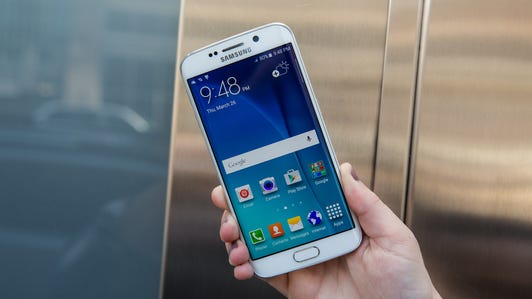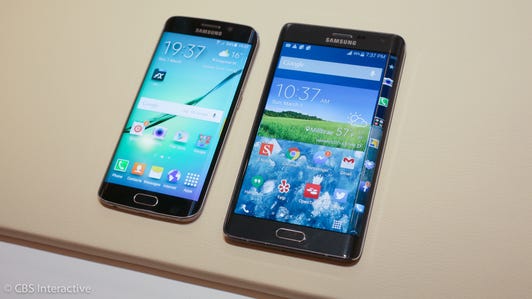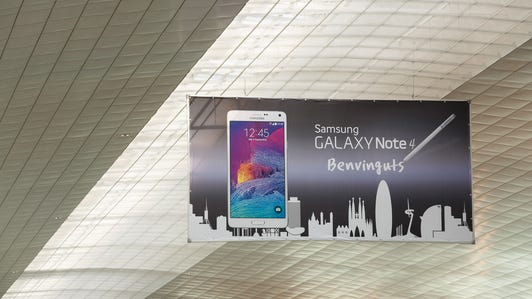
Stephen Shankland/CNET
Sean Lamar stood behind the Best Buy store counter on a chilly February evening, waiting for customers to browse the smartphones arranged neatly along the tables nearby.
Most ask about Apple’s iPhone or the Sony Xperia. But there’s a word he’s heard uttered only once by a customer in his seven months as an employee at the Midtown Manhattan store: Snapdragon. That’s the name of Qualcomm’s mobile chip, which is used in most of the world’s top-end smartphones, from the HTC One M9 to the Samsung Galaxy Note 4 to the LG G3.
“Unless you’re tech savvy, they do not care,” Lamar said about customers interest in mobile chips.
Unlike personal computers, which most folks know are powered by an Intel chip (thanks to the “Intel Inside” marketing campaign that made famous its five-note jingle), most people don’t know or care about what chips are in their smartphones and tablets, so long as their gadgets work. That’s why just about every mobile chip company faces a problem today: A lack of consumer awareness.
Processors, the small computer brains that make your device do everything from running apps to fetching stored photos, are made by a variety of companies and can be easily swapped in a phone without the device maker having to worry that consumers will complain.
It’s also harder to convince device makers to pay a premium for more feature-rich chips when customers don’t know the difference between a top-of-the-line processor and a bare-bones one.
Consider Samsung, which unveiled its new Galaxy S6 smartphone on Sunday. The handset uses a Samsung Exynos processor in place of Qualcomm’s Snapdragon — depsite having used Snapdragon since the Galaxy S line started. The loss of one of the year’s biggest phones is expected to be a substantial hit to Qualcomm’s finances, as well as a blow to the reputation of its new Snapdragon 810 chip.


Ben Fox Rubin/CNET
But will consumers care? Probably not. Samsung was able to pull off a switch because Qualcomm, despite being the world’s largest mobile-chipmaker, isn’t well known among consumers, analysts say. And so, if Qualcomm and other mobile chipmakers want to protect their businesses in the future, they may have to start doing more to raise their profile, following Intel’s playbook of creating a name for itself through aggressive marketing.
“Every component guy wants to find a way to brand themselves to the consumer,” said NPD analyst Stephen Baker, adding that creating a strong brand can inspire a sense of trust and customer loyalty, and ultimately prevent the loss of business. But, in the chip world today, he said, “You’ve got Intel and basically nothing else.”
Qualcomm declined to comment for this article. Samsung declined to say why it was switching to Exynos, though the thinking is it may have done so because it developed a more advanced manufacturing process for its own chip than the 810 offers, creating a potentially more powerful chip.
Branding an ingredient
In most industries, making customers care about the ingredients in a final product is incredibly hard. But it’s been done before. Michelin successfully advertised its tires to customers as a safety feature, and DuPont built awareness for synthetic fibers like Lycra, by placing its tags on clothing, according to Jack Trout, president of marketing strategy firm Trout & Partners.
Intel became the dominant PC chipmaker with the help of its long-time “Intel Inside” marketing campaign and that memorable tune. Intel managed to reach customers “through significant investment and making good on that promise” to have products work as advertised, said spokesman Bill Calder. Graphics chipmaker Nvidia, too, has made a name for itself among PC gamers by aligning itself with gaming events.
But in mobile, even Intel — the world’s biggest chipmaker — has failed so far to get people to care about whether it is indeed inside a smartphone. For one thing, it’s difficult to get noticed when Apple and Samsung, the top two smartphone makers, take up most of the oxygen in mobile and advertise heavily. In comparison, plenty of names in the PC market compete for attention — and many of them happen to use Intel chips.
Double-edged sword: Samsung’s curved Galaxy S6 Edge (pictures)






In 2013, Qualcomm spent nearly $12 million advertising in the US and Intel spent $85 million, while Samsung and Apple both spent over $600 million, according to Kantar Media. That much spending from the leading smartphone companies makes it tough for smaller handset makers like HTC and LG to get noticed, let alone a chipmaker whose product resides inside a device.
Qualcomm, whose chips are used in Apple’s iPhone and dozens of other high-profile devices, hasn’t needed to advertise all that much to customers. It instead pitched itself to device makers and has sold billions of chips in the process. It now holds the majority of the smartphone chips market, with 2014 revenue of $26.5 billion and profit of $8 billion.
Still, it’s not as if Qualcomm hasn’t tried to build up the Snapdragon name. The chip has its own cartoon dragon mascot and the company even temporarily renamed Qualcomm Stadium in its hometown San Diego as Snapdragon Stadium in 2011. In China, the company has been more aggressive marketing itself within retail stores, which may have helped it differentiate against many cheaper options there.
But doing more would be costly, particularly when trying to gain airtime in the same space as Apple and Samsung. “It’s expensive to do that kind of marketing,” said Gartner analyst Jon Erensen. “You really have to get out in front of customers.”
RELATED STORIES
- Magnetic fields make wireless charging a whole lot cooler (hands-on)
- LTE Broadcast promises to make over-the-air app updates hassle-free
- Samsung Galaxy S6, Galaxy S6 Edge restyle Samsung’s image with curves, metal, glass (hands-on)
The name game
Because it’s so difficult to stand out as a smartphone chips company, several experts said a bigger ad budget wouldn’t be worth it for a company like Qualcomm. They claimed the best way to regain Samsung’s business is to keep its focus on maintaining its leading edge in mobile technology and promoting that fact to manufacturers, not customers.
“Reaching an end user with an ingredient story is very, very difficult,” Trout said. “It’s almost impossible.”
Mobile chips may be invisible to most consumers, but that doesn’t mean they’re all the same. Any buyer that cares about getting a phone that’s more capable of streaming video, running graphics-heavy games or capturing high-resolution video may want to pay attention to the chips inside.
Efforts to more clearly define these chips are already underway, and that may help customers get a better idea on what they’re buying. Qualcomm last month said it would start organizing its radio chips under the new names Snapdragon X5 to X12, to let people know which chips have the fastest download and upload speeds (the ones with higher numbers) . The move replaces more esoteric names like Gobi 9×35. The company already has a tiered system with its processors, starting with the high-end 800 chips down to the budget 200 chips.
Barcelona braces for Mobile World Congress 2015 (pictures)






Intel last month said it would name its new mobile chips the Atom x3, x5 and x7, in a nod to its successful Core i3, i5 and i7 chips for PCs. People may not know the exact difference between an x3 and an x7, but they’ll get the point that the x7 is more powerful. Also, Google is working on a new kind of smartphone called Project Ara that lets users mix and match processors, displays and cameras to create personalized smartphones. Such a project may make customers a little more aware of what’s available.
Perhaps these changes won’t get consumers to mention the word Snapdragon more often at their local Best Buy, but it’s a start.



